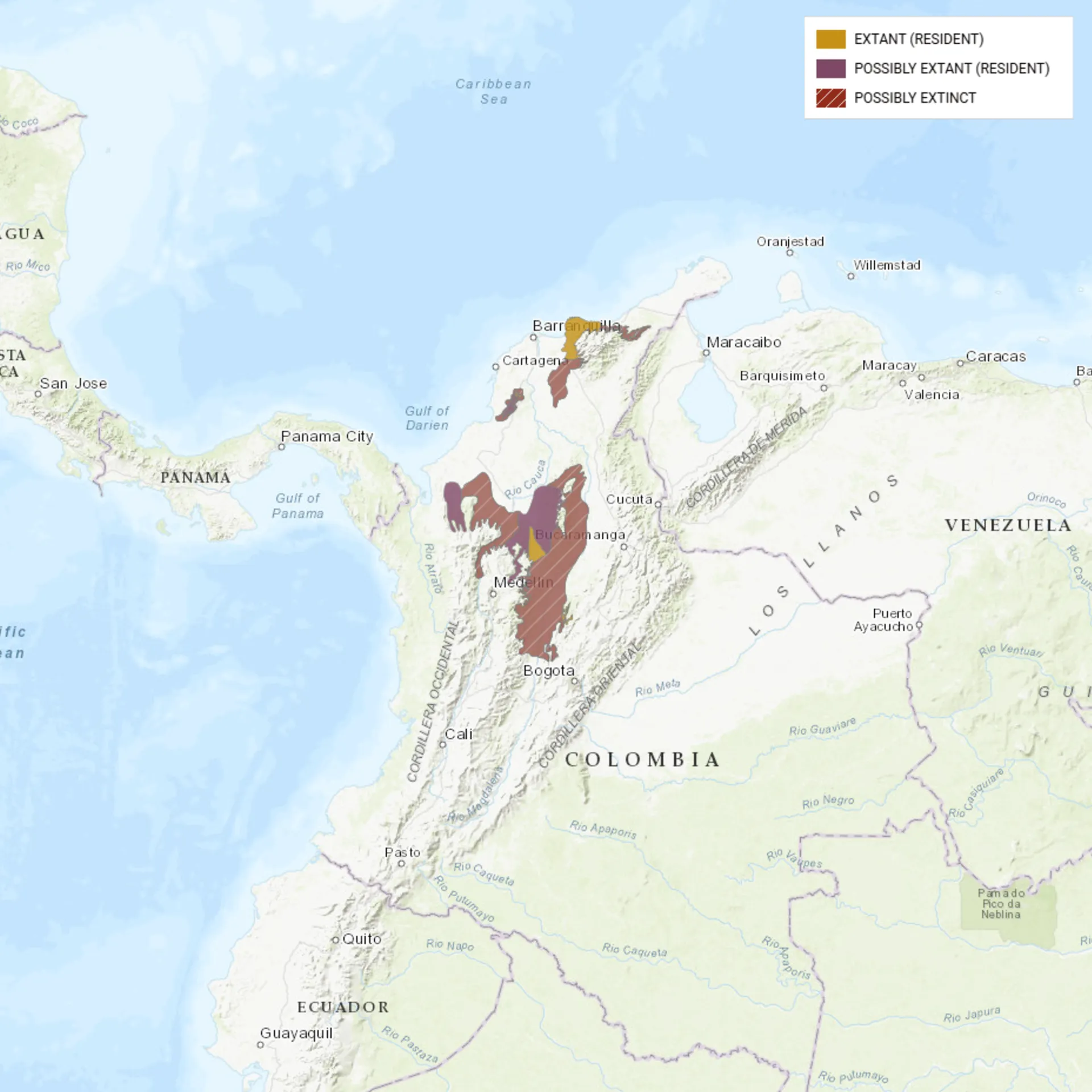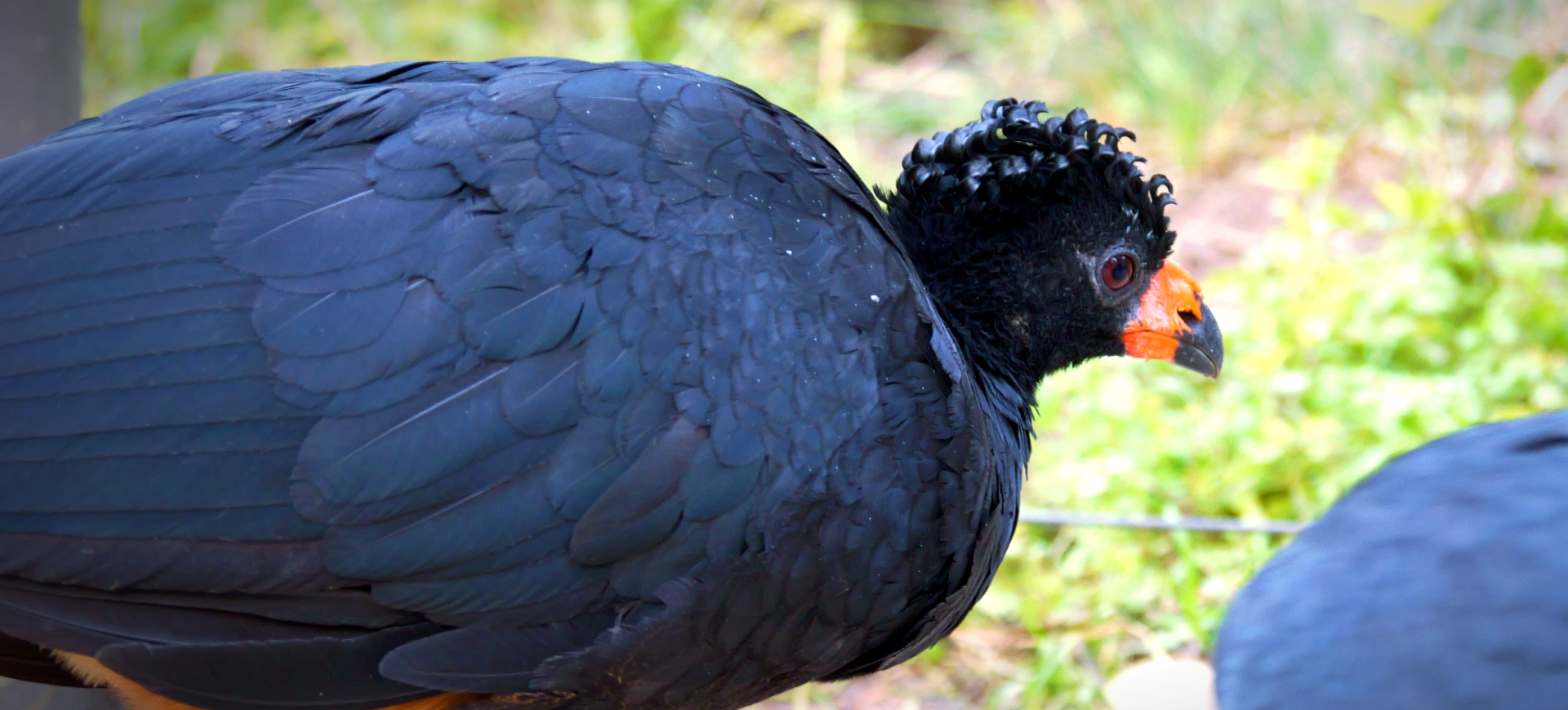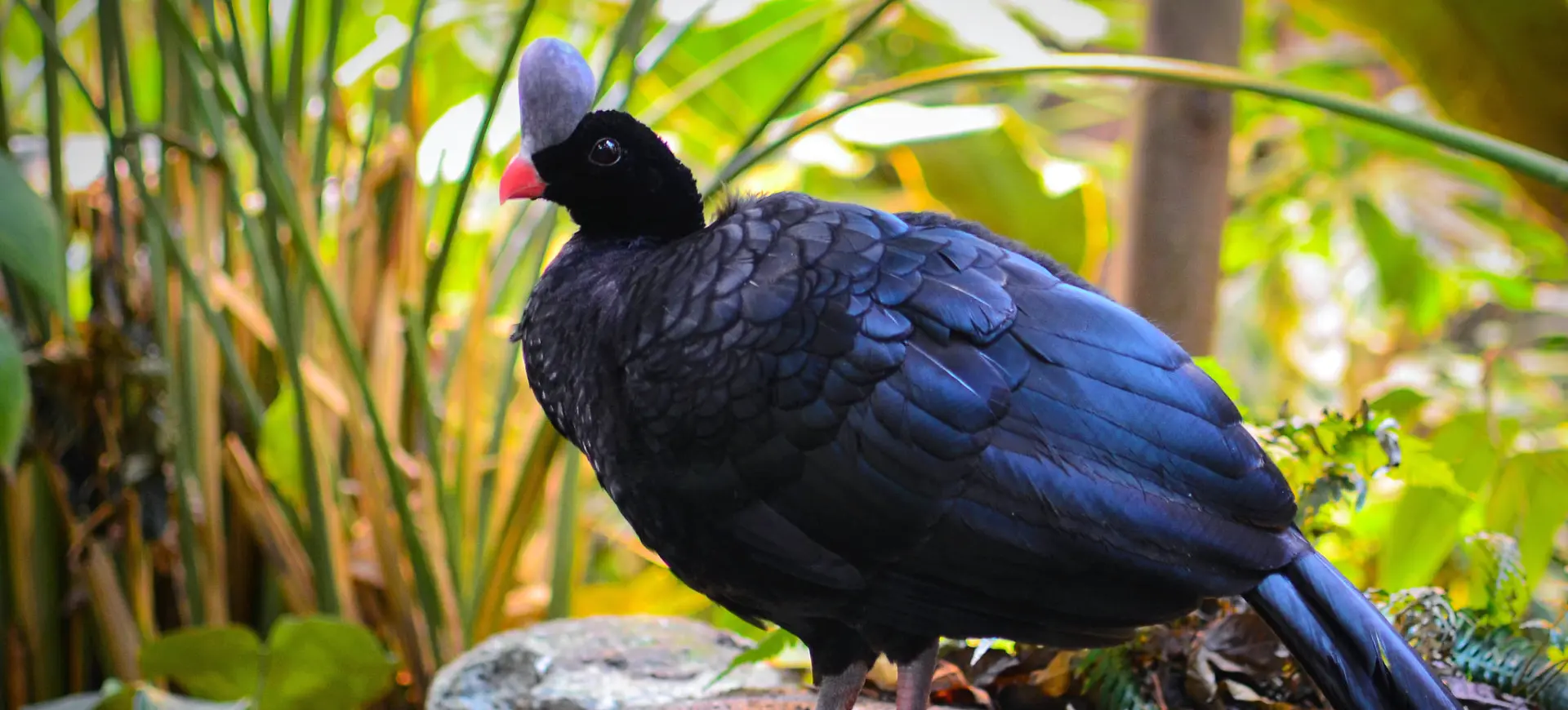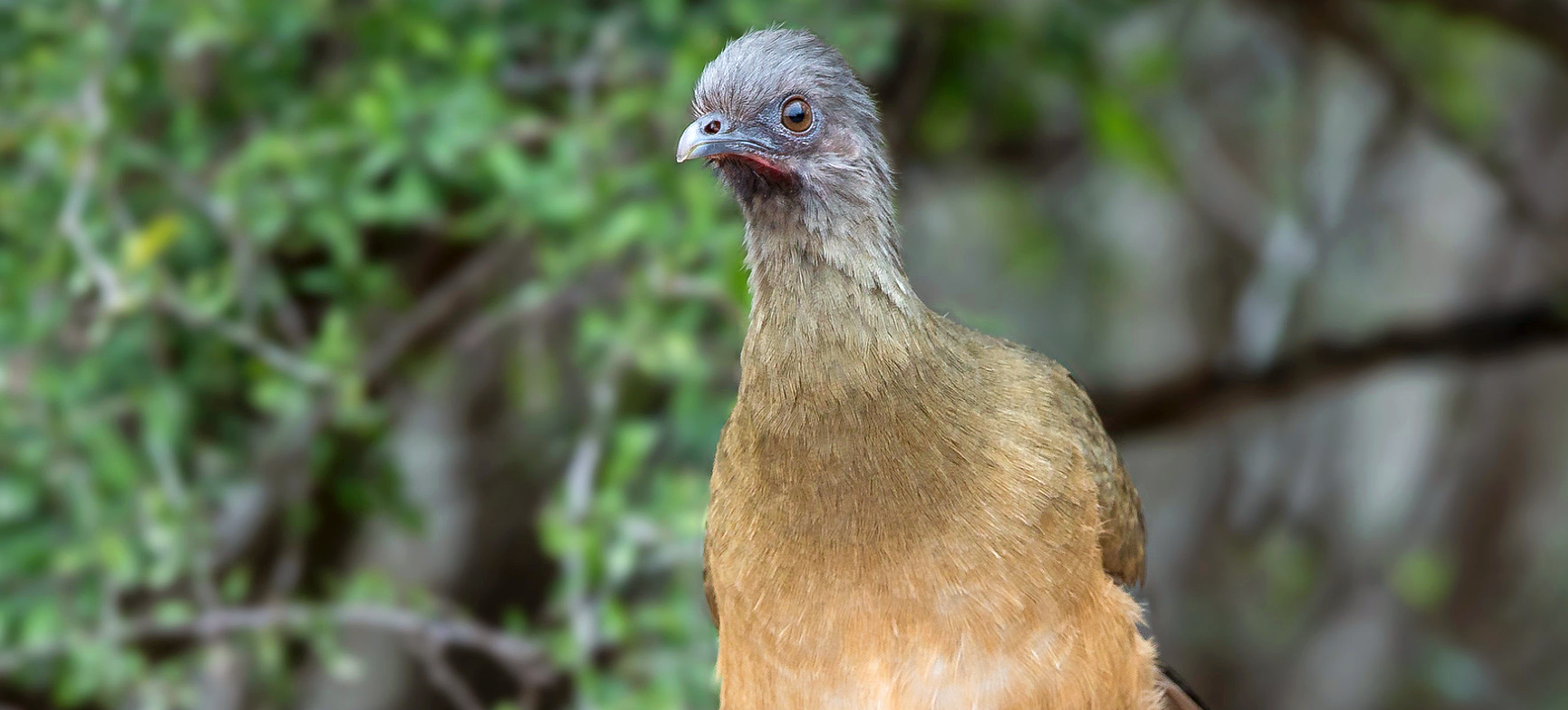Overview
The Blue-billed Curassow (Crax alberti) is a critically endangered bird species primarily found in Colombia. This bird is notable for its distinctive blue bill and crest of curled feathers on its head. The male has a black body with a white belly and a striking blue bill, while the female is primarily brown with black-and-white barred underparts. They are known for their elusive nature, preferring dense lowland forests and challenging studying them in the wild.
The Blue-billed Curassow is part of the Cracidae family, which includes other cracids like guans and chachalacas. Thanks to their fruit-based diet, they play a significant role in their ecosystem as seed dispersers. The species is under severe threat due to habitat loss and hunting. Conservation efforts are crucial to prevent their extinction, with various organizations involved in habitat protection and breeding programs.
Being a ground-dwelling bird, the Blue-billed Curassow is particularly vulnerable to changes in its habitat. They are known for their deep, booming calls, which researchers often use to track them in their dense forest habitats. Their secretive nature and the inaccessibility of their preferred environments have resulted in limited public awareness about their plight, further complicating conservation efforts.
Taxonomy
Kingdom
Phylum
Class
Order
Family
Genus
Species
Type
Current distribution:
The blue-billed curassow is endemic to the remaining fragments of the Atlantic Forest in eastern Brazil, with its distribution confined to a few isolated regions. Its occurrence is now limited to protected areas and privately conserved forest patches, where efforts have been made to maintain viable populations. Extensive deforestation and habitat fragmentation have resulted in a highly discontinuous distribution, with many areas where the species once thrived now completely devoid of its presence. The restricted range of this bird makes it particularly vulnerable to localized threats and environmental changes.
Current surveys indicate that wild populations of the blue-billed curassow are very small and declining, with estimates suggesting fewer than 1,000 individuals remain in the wild. Human-dominated landscapes often isolate these fragmented populations, hindering gene flow and increasing the risk of local extinctions. Conservation programs are working to map the exact distribution and identify critical areas for protection and potential habitat corridors. Ongoing research and field surveys remain vital to better understand its distribution patterns and to implement targeted conservation strategies.
Physical Description:
The Blue-billed Curassow is distinguished by its striking physical appearance. Males possess a predominantly black plumage, contrasting white belly, and a unique, vibrant blue bill. They also have a distinctive crest of curled black feathers atop their head, which adds to their charismatic presence. Females, in contrast, are mostly brown with a pattern of black-and-white bars on their underparts, lacking the vivid blue bill of the males.
In terms of size, this species is relatively large for a forest-dwelling bird. They have strong, sturdy legs adapted for a primarily terrestrial lifestyle. Their short, rounded wings indicated a bird more adept at walking than long-distance flying. The blue bill of the male is not just a colorful display; it also plays a role in mating rituals and territorial displays.

Lifespan: Wild: ~20 Years || Captivity: ~20 Years

Weight: Male: 6.6-8.8 lbs (3-4 kg) || Female: 5.5-7.7 lbs (2.5-3.5 kg)

Length: Male & Female: 30-35 in (76-89 cm)

Height: Male & Female: 32-36 in (81-91 cm)

Top Speed: Unknown
Characteristic:
Native Habitat:
The Blue-billed Curassow is native to Colombia, inhabiting the lowland tropical forests. These forests provide a crucial habitat, offering food resources and the dense cover they require. The species is adapted to live in humid, dense forests where they can find a variety of fruits and shelter from predators.
Their preferred habitat is characterized by a thick understory and a closed canopy, which offers protection and abundant food resources. They are known to inhabit both primary and secondary forests but prefer undisturbed areas. The complex structure of these forests provides opportunities for foraging, nesting, and roosting, which are crucial for their survival and reproduction.
Climate Zones:
Biomes:
WWF Biomes:
Biogeographical Realms:
Continents:
Countries:
Diet:
Diet & Feeding Habits:
The Blue-billed Curassow primarily feeds on fruits, which comprise a large part of their diet. This frugivorous habit plays an important ecological role, as these birds help in seed dispersal for many tree species. They are known to consume various fruits, often falling to the forest floor, which they forage using their bills.
In addition to fruits, they eat small animals, including insects and small reptiles, providing them with necessary proteins. They have been observed foraging in the early morning and late afternoon, often in pairs or small groups. Their foraging behavior is relatively quiet and discreet, aligning with their elusive nature. During the breeding season, their diet may change slightly, with an increased intake of protein-rich foods to support reproductive activities.
Mating Behavior:
Mating Description:
The Blue-billed Curassow has a fascinating mating system characterized by complex behaviors. Males engage in elaborate displays to attract females, including puffing up their plumage, spreading their tails, and showcasing their vibrant blue bills. Deep, booming calls that resonate through the forest often accompany these displays.
The mating season for the Blue-billed Curassow typically occurs at the start of the wet season. This timing ensures that abundant food will be available when the chicks hatch. Nesting usually occurs in low branches or on the ground, where the female constructs a simple nest. After mating, the female is responsible for incubating the eggs and raising the chicks.
Reproduction Season:
Birth Type:
Pregnancy Duration:
Female Name:
Male Name:
Baby Name:
Social Structure Description:
The Blue-billed Curassow is generally a solitary or pair-living bird, especially outside the breeding season. They are territorial, with pairs or individual birds maintaining specific forest areas as their territory. These territories are defended against other conspecifics, particularly during the breeding season.
In the breeding season, their social structure becomes more pronounced, with males displaying to attract females and establish pair bonds. Once paired, they remain monogamous for the duration of the breeding season. Parental care is primarily the female’s responsibility, who incubates the eggs and cares for the chicks. The chicks are precocial, meaning they are relatively mature and mobile at birth but still rely on their mother for protection and guidance.
Groups:
Conservation Status:
Population Trend:
The population of the Blue-billed Curassow has been in a steady decline for several decades. The primary cause of this decline is habitat loss due to deforestation for agriculture, mining, and urban development. Their populations are now highly fragmented, which increases their vulnerability to extinction.
In addition to habitat loss, they are also threatened by hunting and trapping. Despite legal protections, illegal hunting remains a problem in some areas. Their populations’ small size and fragmented nature make them susceptible to genetic bottlenecks, which can further endanger their long-term survival. Conservation efforts are critical to reverse these trends and ensure the survival of this unique species.
Population Threats:
The major threats facing the Blue-billed Curassow are habitat loss and fragmentation. Large-scale deforestation for agricultural expansion, cattle ranching, and urban development has dramatically reduced their available habitat. This reduces their living space and isolates populations, making genetic diversity and breeding opportunities scarce.
Illegal hunting and trapping pose another significant threat. Despite being legally protected, these birds are still hunted for food and captured for the pet trade. Their ground-dwelling nature makes them more vulnerable to terrestrial predators, particularly in areas where their natural habitat has been disturbed. Climate change is also a looming threat, as it could further alter their habitat and affect food availability.
Conservation Efforts:
Conservation efforts for the Blue-billed Curassow are focused on habitat protection and restoration. Several protected areas have been established in Colombia to preserve the remaining habitats of this species. Efforts are also being made to connect fragmented habitats through ecological corridors, allowing for greater genetic exchange between populations.
Captive breeding programs are another key component of conservation strategies. These programs aim to breed individuals in captivity and potentially reintroduce them into the wild. Education and awareness campaigns are crucial to reduce hunting and trapping pressures and to promote conservation measures among local communities. International organizations also provide support and resources for these conservation initiatives.
Additional Resources:
Fun Facts
- The Blue-billed Curassow’s unique blue bill is a characteristic feature only found in males.
- They can produce various vocalizations, including low-pitched booming calls, which are used for communication and during mating displays.
- Despite being ground-dwellers, they can usually travel distances to avoid predators or roost trees.
- The Blue-billed Curassow is one of the few bird species where the female is more brightly colored than the male, a trait uncommon in the bird world.
- They play a crucial role in their ecosystem as seed dispersers, aiding in the regeneration of tropical forests.
- This species is considered an “umbrella species” for conservation, meaning protecting them also protects many other species in the same habitat.
- The crest of curled feathers on the head of the male is used in courtship displays and can be raised or lowered depending on the bird’s mood.
- They are one of the larger members of the Cracidae family, with their size being a distinguishing feature.
- The Blue-billed Curassow’s diet changes seasonally, depending on the availability of fruits and other food sources.
- Due to their elusive nature, much of what is known about their behavior and ecology comes from observations of captive birds.










